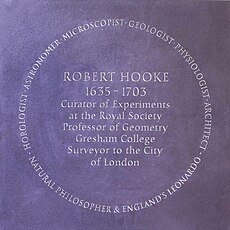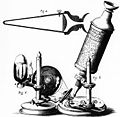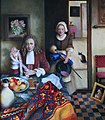Robert Hooke
跳至導覽
跳至搜尋
英國科學家  Retrat per Mary Beale de "un matemàtic" que es suposa de Robert Hooke (vers 1680). | |||||
| 上傳媒體 | |||||
| 母語人名 |
| ||||
|---|---|---|---|---|---|
| 出生日期 | 1635年7月18日(格里曆) 清水鎮 (英格蘭王國) | ||||
| 死亡日期 | 1703年3月3日(格里曆) 倫敦 (英格蘭王國) | ||||
| 墓地 |
| ||||
| 國籍 | |||||
| 就讀學校 | |||||
| 博士生導師 | |||||
| 職業 | |||||
| 僱主 | |||||
| 成員屬於 |
| ||||
| 擔任職務 |
| ||||
| 工作領域 | |||||
| 父親 |
| ||||
| 母親 |
| ||||
| 工作地點 | |||||
| 主要作品 |
| ||||
| 所獲獎項 |
| ||||
 | |||||
| |||||
-
This is probably not a portrait of Robert Hooke, see Robert Hooke talkpage
-
His microscope
-
This one includes the schematic sketch. From Micrographia
-
Greyscale picture of Robert Hooke's drawing of a flea in his Micrographia.
-
He was the first to apply the word "cell" to biological objects: Cork. From Micrographia.
-
'The Fossil Hunter'. Robert Hooke as a ten year old on the Isle of Wight where his father was a curate. Hooke is shown where he was born and brought up, at Freshwater Bay. Oil on board by Rita Greer 2005.
-
'Robert Hooke on the Isle of Wight'. Hooke's father was the curate of All Saints' Church, Freshwater, (shown in the background), near the sluggish river the Western Yar. Although still a boy, Hooke made a model boat that would fire off cannon as it sailed. At the age of thirteen, after the death of his father, who had left him £40, he left his mother and moved to London to be educated at Westminster School after first abandoning an apprenticeship with the artist Sir Peter Lely. This painting was presented to The Robert Hooke Society on the Isle of Wight and hangs in The Planetarium. Oil on board. Rita Greer 2008.
-
'School'. About 1652, Robert Hooke as a pupil at Westminster School, aged seventeen years. Dr. Richard Busby, the headmaster, wears his large hat. Hooke was researching ways of flying and holds a pet linnet. Oil on board by Rita Greer 2005.
-
'The Scientists'. After Robert Hooke had finished his education and secured his doctorate at Christ Church, Oxford, he assisted Robert Boyle in his work. Robert Hooke is setting up an experiment using the air pump he designed and made. It is taking place at the rear of an apothecary's shop in Oxford owned by Dr. Cross. Hooke is fitting on the glass globe while Boyle supervises. The artist has used Hooke's own working drawing of the air pump for accuracy. Oil on board. Rita Greer 2007.
-
'Hooke at Home'. For nearly forty years, until he died in 1703, having been appointed Professor of Geometry, Robert Hooke lived and worked at his rooms in Gresham College in the City of London. In this painting he has returned home from shopping with a Moroccan carpet, lace, fabrics, Dutch paintings, wine, fruit and goose quills. The servant girl holds a bolt of blue silk from the Far East which he mentioned in his diary. Oil on board by Rita Greer 2006.
-
'Robert Hooke and Astronomers at Gresham College'. Hooke designed and made a large telescope which could be hauled up a mast and tilted. His rooms as Professor of Geometry are shown in the corner. Here he lived and worked for most of his adult life, lecturing, researching, writing and setting up experiments for The Royal Society. Oil on board. Rita Greer 2008.
-
'Hooke and Pepys'. Robert Hooke's sensational book 'Micrographia' was published in 1665. He made drawings which were turned into engravings of what he could see down a microscope he had made himself. Samuel Pepys bought a copy and said it was the most ingenious book he had ever read in his life. The most famous image from the book is probably Hooke's drawing of the flea. Oil on board by Rita Greer 2005.
-
'The Great Fire of London 1666'. The city is depicted on September 4, the third day of the fire. Robert Hooke was in London at the time. Fortunately, the fire did not reach his rooms at Gresham College. Such terrifying destruction is on a par with the firestorms after World War II bombings. The narrow streets, timber-framed, thatched houses would later be replaced by brick, stone and tiled buildings to prevent such a tragedy happening again. Oil on board. Rita Greer 2008.
-
'Robert Hooke, Surveyor'. After the Great Fire of London in 1666, Robert Hooke was appointed Surveyor to the city. He is shown measuring and staking out the streets ready for rebuilding. It was a dangerous, difficult and dirty job but he seems to have regarded it as his civic duty. It went on for several years and he carried it out meticulously, with honesty, dealing fairly with people on all levels. Oil on board. Rita Greer 2008.
-
'The Coffee House'. Coffee Houses played an important part in the social life of Robert Hooke. Only coffee and chocolate were served (no alcohol). Here news could be had, conversation, arguments, meetings, card games, wagers made, workmen could be paid, etc.(Hooke would sometimes carry out a scientific experiment in front of a coffee house audience as witnesses.) Hooke is shown writing (bottom left) at a table with people waiting to talk to him. Oil on board. Rita Greer 2008.
-
'The New City'. After the Fire of London in 1666 Robert Hooke and his friend and colleague Christopher Wren worked to rebuild the city. Hooke's main task was surveying and planning and Wren's was building St. Paul's Cathedral and many churches. There is now a memorial to Hooke in the cathedral, adjacent to Wren's tomb. Another memorial to him is cited near The Monument which was designed by Hooke and Wren. It stands 202 feet high and is the tallest isolated stone column in the world. Inside it could house a telescope with a viewing room in the cellar and the column as part of it. Oil on board. Rita Greer 2004.
-
'The Meeting'. On 6 October 1675, Robert Hooke and his close friend and colleague Christopher Wren were walking in St. James's Park. King Charles II was out for a walk with his dogs and the Court. He called the two friends over to discuss inventions. Hooke is showing him a pocket watch for which he had invented the spring balance mechanism. In the background is the palace of Westminster and Horseguards Parade. The two men have removed their hats which was obligatory in the presence of the king. Oil on board by Rita Greer 2006.
-
As no contemporary portrait of Robert Hooke seems to have survived from the seventeenth century, this one is a reconstruction from the descriptions by his colleagues Aubrey and Waller. It shows him with a spring, pocket watch, fossil and map of the City of London after the Great Fire of 1666. He helped to survey and plan the rebuilding. The sky on the left indicates his interest in astronomy. Oil on board by Rita Greer 2004.
-
No drawing of Robert Hooke seems to have survived. This one is reconstructed from contemporary descriptions by two close friends – John Aubrey and Richard Waller. Note the popping eyes, thin face and nose, sharp chin and small mouth with a thin upper lip, also a highly intelligent appearance. Pencil drawing by Rita Greer 2006.
-
Robert Hooke memorial portrait for The Open University. One of a series of memorials. The sky represents his astronomy interests with one of his large telescopes. Spread in front of him are his book 'Micrographia', microscope, spring, meteorites etc. Oil on board by Rita Greer 2008. The portrait hangs in the Seminar Room of the Robert Hooke Science Building and was unveiled in 2009.
-
'The Frost Fair'. The winter of 1683-4 was exceptionally severe. The Thames froze over allowing a tented city to be set up for stalls, booths, shops and entertainments. The 2000 or so watermen made their boats into sleds or put wheels on them and pulled their customers across the ice. Oil on board. Rita Greer 2009.
-
'Robert Hooke, Engineer'. A memorial portrait presented to the Department of Engineering Science at Oxford University in 2009. It shows Hooke in Oxford with important work – a wheel barometer, his microscope and copy of 'Micrographia', a pocket watch, optic, spring and universal joint. He is holding a chain to make a catenary arch and on the wall behind him is a map of the City of London which he helped to survey and rebuild after the Great Fire of 1666. Oil on board by Rita Greer 2009.
-
A memorial portrait of Robert Hooke for Gresham College, London, where Hooke was Professor of Geometry. It lists his varied achievements and shows him with his record book of experiments for The Royal Society, a spring and quill pen, dressed as a gentleman. The painting hangs at Gresham College. Oil on board. Rita Greer 2007.
-
'Willen Church'. Robert Hooke designed this charming little English church for his old headmaster, Dr. Richard Busby, in 1680. It is now Hooke's only surviving church, built on Busby's estate in Buckinghamshire. The lead cupola and weather vane were removed by the Victorians and Dr. Busby had a vestry built each side of the tower with more pineapples. Apart from these changes it is pretty much the same as it was when built. In 2009 Willen church is open and manned every day, combining with other parishes in the area to form an Ecumenical church serving a large area of Milton Keynes. The painting in oils shows the church when newly built without the vestries but with the cupola and weather vane. Robert Hooke poses as the architect, a gentleman from London in the latest fashion.
-
'The Great Plague 1665'. Like many who could afford to, Robert Hooke left London for six months during the worst of the bubonic plague. All cats and dogs were destroyed as a preventive measure. This allowed rats to flourish and spread the disease which was carried by their fleas. The image shows a scene of horror. After sunset carts were driven through the streets to collect the dead. They were taken to the nearest graveyard to be buried in plague pits. Fires burned to make smoke. Pipes of tobacco were smoked, posies of herbs worn and faces covered with masks. This was thought to be protection against contagion. London was overwhelmed with fear, terror and grief. It is thought that as many as 100,000 perished in London alone.
-
This small church is not far from the Open University in Milton Keynes. It is the only surviving church designed entirely by Robert Hooke (circa 1680) for his old Westminster School headmaster, Dr. Richard Busby. It was built on Busby's estate for a parish of 45 people. Rita Greer produced this black and white pen and wash portrait of Robert Hooke in 2009. It shows the church in the background. It was presented to the church in April 2009 at a service of thanksgiving to celebrate a new roof and renovations.


























